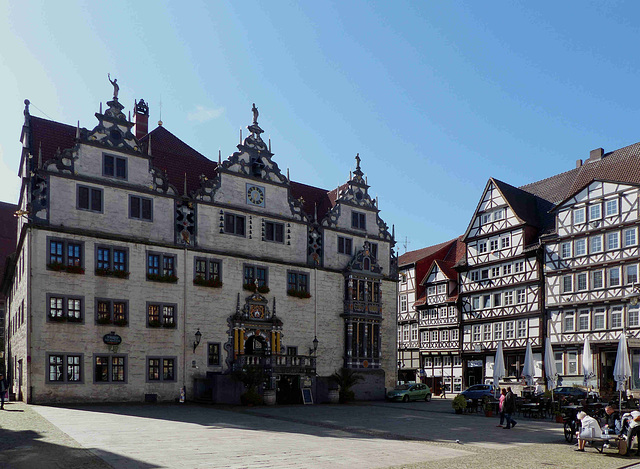Amberley Bridge and Toll House, Sussex
St. Andrews Church, Greensted, Essex
Pont Saint-Thomas - HFF
Ongar Station
HFF
château de Maintenon - Eure-et-Loir
Old City Hall, Toronto
Yarra River.
St Conan's Kirk
Old Hatfield
Farm Under Clouds.
St Etheldreda's, Old Hatfield
Sunday Welcome
il guardiano
triste abbandono
Das Zöllnerhaus in Lübeck
HFF
HFF 4 Aug 2023
Bosco Verticale
Canada Tour `Ksan native village 1xPIP
hWW....hanseatische Wonder Wall :)
HFF to all!
Rathaus Hamburg-Wilhelmsburg
Salford
Lübeck, Burgtor (Feldseite)
Óbidos, Portugal
Lübeck, Burgtor (Stadtseite)
Ruines du château de Gurçon (Carsac de Gurçon,24,…
Braemar Hospital
Welsh National Museum c.1964
Coselpalais (in Dresden).
Naumburg - Rathaus
Castle hotel
Lübeck, Holstentor (Feldseite)
The Wey, the Truth and the Life
Bad Oldesloe, ehemalige Wassermühle
Location
See also...
Keywords
Authorizations, license
-
Visible by: Everyone -
All rights reserved
-
40 visits
Hannoversch Münden - Town Hall


Hann. Münden (short for Hannoversch Münden) lies at the confluence of the Fulda and Werra rivers, which join to form the Weser. The founding of the city is not exactly documented. The first mention in a document from 1183 speaks of a city. Around the year 1200 the construction of the city fortifications of Münden began as a city wall with city gates and wall towers.
The shoal of the Werrahohl on the outskirts of the city, which forced the boatmen to unload their goods in the city, was advantageous for Münden. In the 16th century, Münden was an important trading town. Accordingly, trading, transhipment and mooring places along the Werra and Fulda shipping routes developed on the western and northern outskirts of the old town. Above all, woad, glass, textiles and rafts with wood and grain were traded and transported. Herring and other fish came up the Weser from the North Sea. At the beginning of the 14th century there were about 500 houses in the village.
In 1525 Elisabeth von Brandenburg was granted Münden as a dominion. Elisabeth came into contact with the ideas of the Reformation early on and brought the reformer Antonius Corvinus to Münden.
In 1776 almost 20,000 Hessian soldiers were embarked in Münden, who had been hired out by the Landgrave of Hesse-Kassel Friedrich II to the Hanoverian Elector and King of Great Britain, George III. They were "used" in combat against American troops in the American Revolutionary War. The return of the soldiers also took place via Münden in November 1783, but hardly more than half returned.
-
The town hall dates back to the 14th century. A conversion at the beginning of the 17th century gave it the Weser Renaissance-style facade that has been preserved to this day. There is a glockenspiel on the facade, which shows a daily rotation of figures with scenes from the life of the legendary Doctor Eisenbarth.
The shoal of the Werrahohl on the outskirts of the city, which forced the boatmen to unload their goods in the city, was advantageous for Münden. In the 16th century, Münden was an important trading town. Accordingly, trading, transhipment and mooring places along the Werra and Fulda shipping routes developed on the western and northern outskirts of the old town. Above all, woad, glass, textiles and rafts with wood and grain were traded and transported. Herring and other fish came up the Weser from the North Sea. At the beginning of the 14th century there were about 500 houses in the village.
In 1525 Elisabeth von Brandenburg was granted Münden as a dominion. Elisabeth came into contact with the ideas of the Reformation early on and brought the reformer Antonius Corvinus to Münden.
In 1776 almost 20,000 Hessian soldiers were embarked in Münden, who had been hired out by the Landgrave of Hesse-Kassel Friedrich II to the Hanoverian Elector and King of Great Britain, George III. They were "used" in combat against American troops in the American Revolutionary War. The return of the soldiers also took place via Münden in November 1783, but hardly more than half returned.
-
The town hall dates back to the 14th century. A conversion at the beginning of the 17th century gave it the Weser Renaissance-style facade that has been preserved to this day. There is a glockenspiel on the facade, which shows a daily rotation of figures with scenes from the life of the legendary Doctor Eisenbarth.
Bruno Suignard, Paolo Tanino, Alexander Prolygin have particularly liked this photo
- Keyboard shortcuts:
Jump to top
RSS feed- Latest comments - Subscribe to the comment feeds of this photo
- ipernity © 2007-2024
- Help & Contact
|
Club news
|
About ipernity
|
History |
ipernity Club & Prices |
Guide of good conduct
Donate | Group guidelines | Privacy policy | Terms of use | Statutes | In memoria -
Facebook
Twitter

Visited there last year.
www.ipernity.com/group/buildings
Sign-in to write a comment.